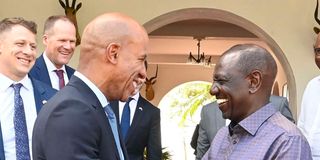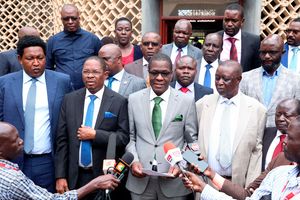Kenya and Uganda in search of financier to revive SGR extension

President William Ruto meets Mr Brian Nelson, the US Department of the Treasury’s Under Secretary for Terrorism and Financial Intelligence, at State House, Mombasa July 28.
Kenya and Uganda have revived the near-dead project to build the Standard Gauge Railway between the two countries, signalling renewed efforts to upgrade infrastructure along the Northern Corridor, with an eye on improved trade.
But the joint declaration issued July 28 by the two governments is highly dependent on how soon a financier comes on board. Lack of money is what killed the earlier plans,leading to the labelling of the SGR as a ‘railway to nowhere.’
This time, ministers in charge of transport from both sides said they had renewed a joint search for the money, which could include loans or an arrangement for Public-Private Partnerships (PPP).
If all goes to plan, the contractor should be on site from December this year to build the SGR extension set to run from Naivasha to Kampala, in the immediate term, before extending to Uganda’s frontier towns with Rwanda and South Sudan.
The two governments on Friday signed the deal to finalise joint resource mobilisation in the next four months to fund the modern railway line from Naivasha to Malaba to Kampala, and from Kampala to Kasese-Mpondwe with a branch line from Bihanga to Mirama hills. Once the project is completed, goods moving from Mombasa to Uganda border with Rwanda and South Sudan will be ferried by SGR, which could speed up delivery, but hurt opportunities for truckers.
The two governments on Friday signed a deal which will also increase the usage of rail to haul Uganda cargo using SGR from Mombasa to Naivasha using SGR and Meter Gauge Railway (MGR) from Naivasha to Malaba border up to more than 100 percent in the coming months.
Uganda Minister of Works and Transport, Katumba Wamala and his Kenya Roads and Transport counterpart, Kipchumba Murkome, signed bilateral agreement. Uganda Minister of Works and Transport, Katumba Wamala and his Kenya Roads and Transport counterpart Kipchumba Murkomen signed a bilateral agreement to this effect.
“The two governments acknowledge the importance of synchronisation of the construction of the SGR section to achieve viability,” read the joint communique issued at Mombasa SGR terminal after the signing of the agreement.
Mr Murkomen said they have already placed their offers to different financiers from Europe and the Middle East who have shown interest in investing. This project was in fact envisaged 8 years ago but fell through as Uganda and Kenya failed to raise financing from China.
In January, Uganda signed a memorandum of understanding with Turkish firm Yapi Merkezi to pave way for the construction of SGR from Malaba to Kampala.
That was after eight years of non-execution despite talks with China Harbour Engineering Company (CHEC) to build the country’s first phase of a 273km SGR line from Malaba to Kampala. Gen Wamala said Uganda is working with a Turkish Company on a feasibility study from Malaba to Kampala and to Kasese and Tororo.
“We are in the final stage of getting financier and we are weighing which will give us best deal and the two government hope to start this before the end of this year through joint funding,” said Mr Murkomen.
The line, starting from the Malaba border post between Uganda and Kenya, was expected to cost $2.2 billion, but the Chinese financiers Kenya had pegged its hopes on did not fund the project after casting doubt on Kenya’s SGR reaching the border to link with Uganda’s, making the project viable. Funding had been conditioned on a joint bid, which both countries (Kenya nd Uganda) could not mount.
In 2019, then President Uhuru Kenyatta on his fourth trip to China failed to secure $3.68 billion to fund the third phase of his signature SGR project to extend to Kisumu, then on to Malaba. Instead, Kenya bagged some $400 million to be used to upgrade its 120-years old metre-gauge-railway to Malaba on the border with Uganda.
Beijing’s assessment indicated at the time that without Uganda, whose participation is key to connecting South Sudan and Rwanda to the Indian Ocean port of Mombasa, the SGR’s viability would be undermined The revived project will be under the Northern Corridor Integration Projects Initiative, which will include Rwanda and South Sudan in future, Burundi and even the Democratic Republic of Congo.





